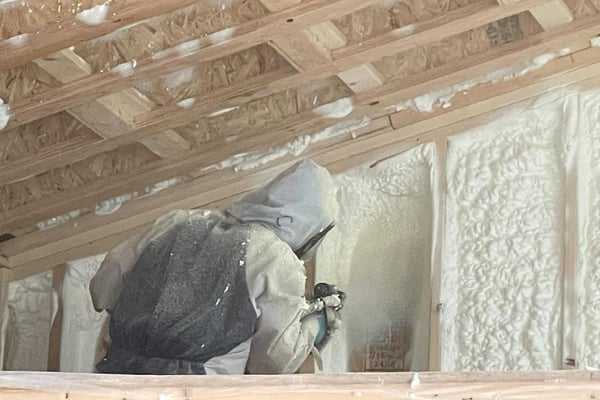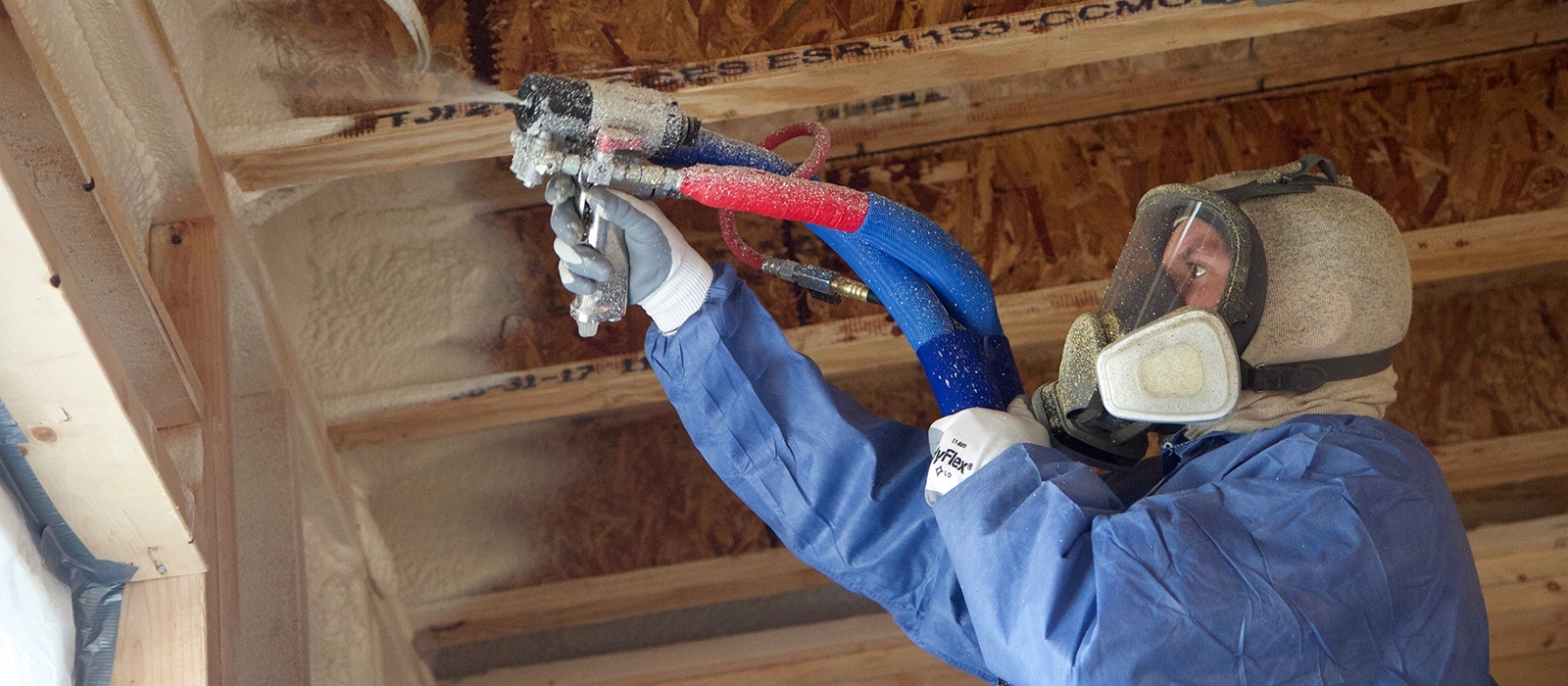Spray Foam: The Ultimate Service for Air Sealing and Insulation
Spray foam insulation has arised as a leading service for efficient air securing and thermal insulation, using a distinct mix of homes that establish it apart from conventional approaches. Comprehending the complete range of its advantages, installation procedures, and contrasts with other insulation kinds is important for making educated choices.
What Is Spray Foam?
Spray foam is a versatile insulation product that combines the concepts of air securing and thermal resistance to enhance power performance in structures. Composed mostly of polyurethane or various other similar substances, spray foam is used as a liquid that broadens upon call with surfaces, producing a strong, continual layer of insulation. This unique residential or commercial property enables it to load gaps, fractures, and gaps that traditional insulation materials might overlook, offering a premium air seal.
There are 2 main sorts of spray foam: open-cell and closed-cell. Open-cell spray foam is lighter and extra flexible, providing exceptional audio absorption and a reduced R-value per inch - Spray Foam. In contrast, closed-cell spray foam is denser, giving a greater R-value, moisture resistance, and added structural honesty to constructing components
The application process usually includes customized tools, ensuring a seamless application that follows different substratums, consisting of timber, concrete, and steel. This adaptability makes spray foam ideal for both brand-new constructions and retrofitting existing structures. Its ability to create an airtight obstacle dramatically adds to reducing energy consumption and boosting interior air high quality, consequently making it a favored choice among building contractors and property owners alike.
Advantages of Spray Foam Insulation
Among one of the most significant benefits of spray foam insulation is its outstanding capability to develop a constant air barrier, which effectively decreases energy loss. Unlike traditional insulation products, spray foam increases to fill up fractures and gaps, making certain that air leakage is considerably decreased. This particular not only boosts energy performance however also results in decrease utility costs in time.
Additionally, spray foam insulation provides remarkable thermal resistance, contributing to a much more secure indoor setting. Its high R-value per inch permits reliable insulation in confined areas, making it perfect for attic rooms, wall surfaces, and crawl spaces. The moisture-resistant residential or commercial properties of spray foam assistance avoid mold and mildew and mold development, promoting healthier living conditions.
An additional critical benefit of spray foam insulation is its sound-dampening top qualities (Spray Foam). It effectively decreases noise transmission in between spaces, developing a quieter and more comfortable home atmosphere. The toughness of spray foam additionally stands out, as it does not sag or work out gradually, keeping its efficiency throughout its life-span
Just How Spray Foam Functions
Recognizing exactly how spray foam insulation functions is crucial for appreciating its effectiveness in air sealing and thermal resistance. Spray foam insulation consists of 2 main elements: isocyanate and polyol material. When these elements are mixed, they undergo a chain reaction that triggers the material to expand swiftly, developing a thick foam that fills up tooth cavities, gaps, and splits.
As the foam increases, it sticks to surfaces, creating a closed seal that substantially minimizes air infiltration. This particular makes spray foam insulation very efficient at avoiding drafts and moisture infiltration, which can lead to energy loss and damages in time. In addition, the closed-cell variation of spray foam provides premium thermal resistance as a result of its rigid framework, efficiently decreasing warmth transfer.
The special properties of spray foam enable it to comply with uneven surface areas, making sure extensive coverage and a smooth barrier. Consequently, spray foam insulation not just enhances power performance yet also adds to improved indoor air top quality by decreasing the buildup of allergens and contaminants. Ultimately, recognizing the auto mechanics behind spray foam emphasizes its role as an exceptional option for insulation and air securing in both business and household applications.
Setup Process Overview

Before installment, the space needs to be properly cleaned up and prepped, making certain that surface areas are totally free from dust, debris, and moisture. Due to the fact that pollutants can compromise adhesion and overall efficiency, this action is critical. As soon as the location is prepared, the application includes Going Here blending the 2 components of the spray foam, which expands upon contact and loads voids properly.
Educated specialists must carry out the installation, utilizing customized tools to make sure consistent insurance coverage and optimum density. Safety precautions, consisting of putting on safety equipment and ensuring correct air flow, are essential during this process. After application, the foam commonly treatments rapidly, forming a strong barrier that boosts power performance.
Comparing Spray Foam to Traditional Insulation
When reviewing insulation choices, spray foam insulation stands out in contrast to conventional materials such as fiberglass and cellulose. Among the key advantages of spray foam is its premium air securing capabilities. Unlike fiberglass and cellulose, which can permit air seepage, spray foam broadens upon application, loading spaces and holes to create a closed seal. This causes improved power efficiency, as much less warmed or cooled air gets away the home, causing lower utility costs.
In addition, spray foam offers a higher R-value per inch than traditional insulation types, using even more effective resource thermal resistance in a thinner profile. This characteristic is specifically advantageous precede with minimal tooth cavity deepness. Spray foam is resistant to moisture and mold and mildew development, which can be a significant concern with cellulose and fiberglass, especially in moist environments.
Nevertheless, spray foam insulation typically lugs a higher ahead of time expense than its traditional counterparts. Home owners must weigh this initial investment against long-term energy cost savings and efficiency advantages. Eventually, while both insulation kinds offer their purpose, spray foam arises as an advanced service for modern insulation requirements, especially in terms of air securing and thermal effectiveness.

Verdict
In recap, spray foam insulation stands for a highly efficient remedy for achieving optimum air securing and thermal resistance. Its one-of-a-kind residential properties, consisting of dampness resistance and audio dampening, make it suitable for various applications in both new building and constructions and retrofitting tasks (Spray Foam). The preliminary costs might be Find Out More greater compared to typical insulation products, the long-term benefits, such as significant power cost savings and improved interior air quality, warrant the financial investment and highlight its worth in modern-day structure practices.
Spray foam insulation has arised as a leading service for effective air securing and thermal insulation, providing a distinct combination of buildings that set it apart from traditional approaches.Spray foam is a versatile insulation product that combines the concepts of air sealing and thermal resistance to improve power efficiency in structures.When assessing insulation alternatives, spray foam insulation stands out in comparison to standard materials such as fiberglass and cellulose. Eventually, while both insulation kinds serve their objective, spray foam emerges as an extra advanced remedy for modern insulation requirements, particularly in terms of air securing and thermal performance.
In summary, spray foam insulation stands for a highly reliable solution for accomplishing optimum air sealing and thermal resistance.